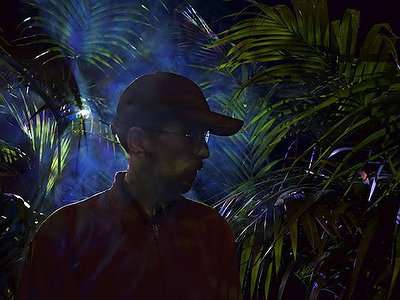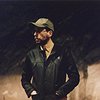Name: Jonathan Uliel Saldanha
Nationality: Portuguese
Occupation: Artist / Musician / Composer
Current Release: Tunnel Vision on SILO RUMOR
Musical Recommendations: The visual artist Diogo Tudela, with whom I’ve been developing a lot of my latest visual works, going specifically deeper with the vibration of light, in a method/system I call “Cintilância”, that comes both from early cinema false colouring techniques (pre-technicolor) and from the term/condition Scintillating Scotoma. His work grows into a deep meditation on coding and the sacred dimension of image. (www.diogotudela.com)
Catarina Miranda is a choreographer and a visual artist. We share common stage work investigations on gesture, trance and violence, we’ve worked together many times, namely on her REI Trilogia (KING Trilogy). She investigates repetition and ceremonial/military languages that are both highly codified and addressing an immaterial motor of mediating the sacred and mediating the law. (www.catarinaamiranda.com)
Website: If you enjoyed this interview with Jonathan Uliel Saldanha, you can find out more information on his website.
When did you start writing/producing music - and what or who were your early passions and influences?
I started in the mid 90s in a very intuitive and clueless way. It was a long period of avid search and discovery; a slow process for mapping what was driving me. Information wasn’t that fast and I was listening to very different sources at the same time (this is maybe a symptom of small town living) but somehow it made the concepts of style or format less important.
All this was accompanied by my deep interest in Indian classical music, and by a regular practice of tabla at that time. It was a very vibrant period where I was discovering Indian music, listening to dub, and to Coltrane’s late work, realizing the visceral and cosmic blast of his music.
My listening kept on growing and the linking elements started to be clearer to me. I began to play in more exploratory contexts, playing with very experimental formats, expanding my set from tabla to percussion and horns, and finally moving deeper into electronics and composition.
For most artists, originality is first preceded by a phase of learning and, often, emulating others. What was this like for you? How would you describe your own development as an artist and the transition towards your own voice?
While studying tabla I understood that it could never evolve into being my single voice; it was destined to fail. I wanted to develop other methodologies, and working with improvisation groups made me expand my vocabulary from within, developing some of my systematic errors into an objective discourse. I was less interested in a traditional or academic phase of mimetic learning, and more in shaping error and impetus.
Also I was learning from very different inputs (musical and non-musical); this made my own sonic construction systems expand beyond (or behind) the instrument and the form. With this process getting embedded in my mind and body, the possibilities started to grow exponentially, to an extent that it became impossible to do anything other than trying to conjure my sounds and images. Flesh to the bones.
What were your main compositional- and production-challenges in the beginning and how have they changed over time?
The challenge was to make real the unfathomable and invisible forms that appeared clear to my mind but still without a body. To define this body, and to acknowledge its shape and skin, was a long process. I learnt by trial and error, with no shortcuts.
My early interest focused on the animism of sound and on processes that can translate that, like dubbing. This made me go deeper into studio techniques and to consider sound in its self-contained shape. From there I went deeper into acoustics (specifically space acoustics) and resonance, where sonic elements could sustain themselves alive at the gestural edge of the non-Euclidean dimensions of time.
Tell us about your studio, please. What were criteria when setting it up and how does this environment influence the creative process? How important, relatively speaking, are factors like mood, ergonomics, haptics and technology for you?
My studio shifted in form a couple of times.
It started out as a maze of images that were intriguing me in different ways and in which I could find some sort of narrative input (diagrams of black holes, portraits of ghosts, pictures of the White House, fake landscapes, movie posters, animals fighting, the human voice apparatus, Russian space program, rocks) all of them part of my personal cosmos, as if I was working on solving an elemental crime, from the forensics of my composition, and through the operation process.
After some years I started to subtract all these images from the walls; somehow these images became impregnated in my mind, so I tend to prefer emptier walls nowadays. But my studio still remains crowded with instruments: all kinds of percussion, wind and brass.
In terms of acoustics, speakers, and gear, I’m very interested in broadcast gear, mainly because of the very positive influence I got from working regularly on the Ångstrom Studio in Brussels. The owner and amazing mastering engineer Frederic Alstadt pushed me deeper into broadcast ethics, few materials, great acoustics and precision on mixing, diffusion, and the AD/DA process.
What are currently some of the most important tools and instruments you're using?
When thinking about instruments I usually have a very simple diagram mapping a chain of events and mutations: impetus-gesture/air-resonance-electricity-data-touch.
The mechanical ear of the microphone is still a fundamental tool for me, even if not used in a naturalistic or figurative way (in the sense of a correct translation of one sound vibrating in the air to a data archive), but rather as an evocation tool.
The Time of resonance and echo also became a fundamental element for my own constructions; caves, tunnels, surfaces and membranes are all materials that I work with in search of resonance and filtering. These architectures of resonance are a medium to define a multidimensional presence of sound, a way to fix a skin to the sonic bodies. This is not so much a localisation in the acoustic field but more of a presence; like any presence, it’s defined by intermediary elements of position, and dimension, and especially of character.
The mixer is still a very important tool/instrument for critical “colour” and musical decisions, but also for giving electricity to the sounds and helping them to find their space in the horizontal plane. All rooting systems are very important for me.
Many contemporary production tools already take over significant parts of what would formerly have constituted compositional work. In which way do certain production tools suggest certain approaches, in which way do they limit and/or expand your own creativity? Are there any promising solutions or set-ups capable of triggering new ideas inside of you as a composer?
With the proper microphones certain instruments can become very advanced “colour” research generators. However the technical evolution of sound synthesis is overwhelming, and I can relate to some of those investigation lines, especially in the combination of synthesis, instruments, and acoustics. All these hybrid set-ups are very interesting.



